(1074 products available)






































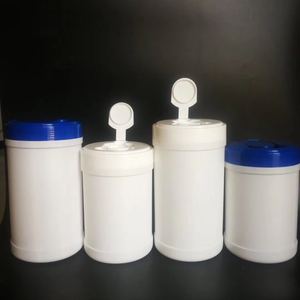




































































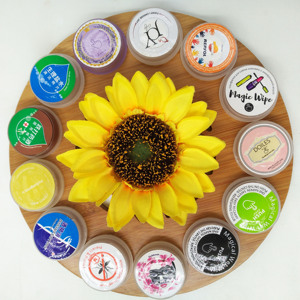



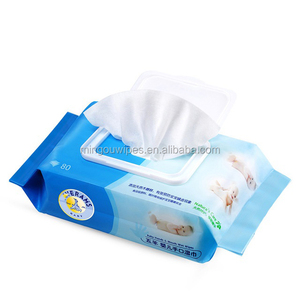




























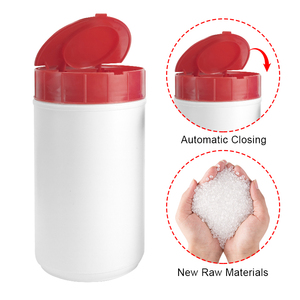
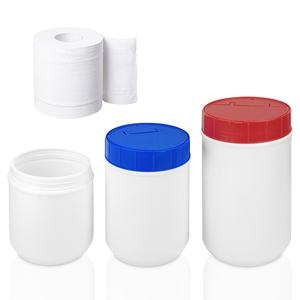




















































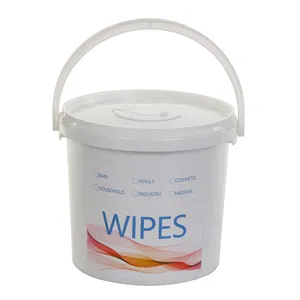































Different types of plastic containers wet wipes can hold wet wipes. Each type is suitable for a different kind of wet wipe.
Flip-top containers
Flip-top containers have a small opening that is easy to access and close. This keeps the wet wipes intact and prevents them from drying out. Only one wipe is taken out at a time. This is convenient for users. The container is rectangular and flat, making it easy to hold in one hand while taking out the wipe with the other hand. A flip-top wet wipe pack is suitable for facial wipes, baby wipes, and moist toilet paper. It is available in various sizes and holds many wipes.
Pop-top containers
These containers are similar to flip-top containers. They have a top that pops open. Like flip-top containers, only one wipe is removed at a time. This prevents other wipes from coming out. Pop-top containers are also rectangular and flat. They are suitable for the same type of wet wipes.
Canister wet wipe containers
Canister wet wipe containers are cylindrical plastic containers for wet wipes with lids on top. They are like bottles that stand upright on a flat surface. The opening on top of the canister is similar to the flip-top and pop-top containers. Users can easily remove one wipe while keeping the others intact. Canister plastic containers for wet wipes are suitable for many kinds of wet wipes. This includes baby wipes, cleaning wipes, and personal care wipes. They can hold up to 1000 wipes, depending on the size of the canister.
Bag with resealable closure
This is a plastic bag that is flexible and can hold many wet wipes. It has a resealable closure at the top, which is similar to ziplock bags. This resealable feature prevents the wipes from drying out. Users can easily open and close it after taking out a wipe. The bag is transparent, so the wipes' packaging color and design are visible. This helps users choose the right wipes quickly. The bag is ideal for travel and can fit in a purse or backpack. It is lightweight and easy to carry. A resealable bag is suitable for all kinds of wet wipes. This includes facial wipes, baby wipes, and antibacterial wipes.
There are many factors to consider when choosing plastic containers for wet wipes. Here are some essential tips to help plastic container buyers make better decisions.
Container Type
Consider the different types of wipe containers available. Flip-top tubs allow easy access to wipes while keeping them moist. Pump-top tubs offer similar moisture benefits but require more effort to lift the top. Pouch-style containers are portable and have a slim profile but may not hold as many wipes. Choose the correct type based on convenience, portability, and the number of wipes needed at once.
Seal and Closure
Check the container's seal and closure to ensure moisture is not lost. Look for airtight seals that prevent wipes from drying out. Snap-on lids tend to have better seals than screw-on lids. Some containers have silicone seals that create an airtight fit when the lid is closed. These features help keep wipes wet for longer.
Size and Shape
Consider the size and shape of the container. Does it fit nicely in the hand for easy wipe removal? Is it portable for on-the-go use? Some containers are square, while others are rectangular or rounded. The shape impacts how the container sits in the hand and on surfaces. Size also affects how many wipes it holds. Choose a shape and size that suits personal preferences and how the wipes will be used.
Durability
Choose a sturdy container that withstands drops and daily use. Thin plastic may crack or break more easily. Thick, durable plastic is better for long-term use. Some containers have reinforced bottoms to prevent damage from impact. Squeeze bottles made from strong plastic are less likely to get dents or dings.
Style and Design
Pick a container that appeals to personal tastes. Many wet wipe containers come in fun colors, patterns, and designs. Some have clear plastic so the wipes inside are visible. Others are completely opaque. Consider style along with function to find a container that will be enjoyed using. Personalization allows self-expression while completing a task.
Cost
Price is another factor to consider when choosing a plastic container for wet wipes. More complex designs and features may cost more. Think about how often the container will be used. Higher-priced containers are usually better quality and last longer. Consider long-term value, not just upfront cost. Quality containers provide better moisture retention and longer wipe usage.
Containers for wet wipes are simple and convenient. Here are some steps to ensure they are used properly:
Opening the Lid:
Carefully lift or twist off the lid, depending on the container type. Some lids flip open, while others slide. This action exposes the opening where the wipes are dispensed. Properly opening the lid prevents damage to the sealing mechanism.
Removing the Seal:
If there is a seal covering the wipe opening, gently peel it off. This step reveals the wipes inside the container. Seals protect wipes from drying out by maintaining moisture. Only remove seals when ready to use the wipes.
Dispensing Wipes:
To take out a wipe, pull it lightly from the top of the stack visible at the opening. Stacking wipes correctly ensures easy single-handed removal. Avoid yanking as this may dislodge other wipes or tear them.
Closing the Lid:
After use, promptly close the lid by snapping or sliding it back into place. This action reseals the container, keeping remaining wipes moist. Always remember to close lids tightly. This simple step maintains wet wipes' intended benefits over time.
The installation of wet wipe plastic containers is simple. There are no special requirements for setting them up or using them. Simply place the container in the desired location and follow the usage instructions. Here are some ideal places to put the containers:
Plastic containers for wet wipes offer convenient storage but raise safety concerns. Here are the main risks:
It is important to properly discard wet wipes and their containers. Do not flush wipes, as they clog toilets and sewer systems. Instead, throw them in the trash. The plastic may not break down in landfills, but proper disposal is essential to prevent environmental damage.
Q1. Can plastic containers be recycled?
A1. Yes, most plastic containers are recyclable. Check the recycling code at the bottom of the container and follow local recycling guidelines. Wipe containers with lids are often reused by consumers to store their own wipes, making them a sustainable choice.
Q2. What is the difference between HDPE and PP plastic?
A2. HDPE wipes container or polyethylene is durable, strong, and resistant to impact, making it ideal for sturdy containers. Polypropylene (PP) plastic is more flexible and heat-resistant, which works well for hinge lids on wet wipe containers.
Q3. Can wet wipes be stored in any plastic container?
A3. Wet wipes need adequate moisture and cannot be stored in just any plastic container. They require airtight seals to maintain wetness and moisture. Containers designed for wipes have features like airtight seals and often have special lids that allow easy dispensing of wipes while keeping the remaining wipes moist.
Q4. Are there any special requirements for storing baby wipes in plastic containers?
A4. Baby wipes need to be stored in a way that keeps them safe from infection and irritation. Therefore, it is important to ensure the plastic container is safe for babies and has not been contaminated. The container should also have an airtight seal to keep the wipes moist and soft for the baby's skin.
Q5. How can one tell a good-quality plastic container for wet wipes?
A5. A good-quality plastic container for wet wipes should be made of durable plastic that won't crack easily. It should have a tight-sealing lid to prevent moisture loss and have a smooth opening for easy single-handed wipe dispensing. Clear or semi-clear options allow users to see the remaining wipes easily.